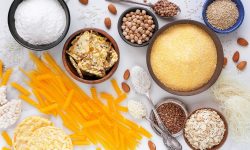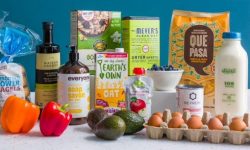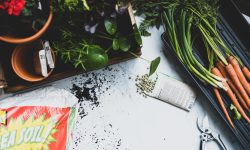Favourite Gluten-Free Items Available at Spud May National Celiac Awareness Month, but every day Spud…
Did you know that most Canadians only consume half the amount of the recommended daily intake of fibre? Fibre does much more than just keep you full after a meal. It can help lower cholesterol and regulate blood-sugar level. It is also crucial for maintaining a healthy digestive system. And while the recommended daily intake of fibre ranges between 25 and 38 grams for an adult, most of us hit well below that target. Luckily, there are many healthy and delicious high-fibre foods that easily help you reach the recommended intake.
There are two main types of fibre your body needs.
Before we delve into what high-fibre foods you should eat. We need to learn about the two main types of fibre.
Insoluble fibre is found in foods including nuts, seeds, fruits, vegetables, whole grains, and wheat bran. It assists in keeping regular bowel movements, adding bulk to the stool, and balancing the pH levels in the intestines. Insoluble fibre is noted to prevent haemorrhoids and diverticulosis while expelling carcinogens and toxins from the digestive system.
Soluble fibre is found in foods including oat bran, fruits, vegetables, and legumes. This fibre slows digestion by absorbing water and turning into gel during digestion. Slower digestion allows for better absorption of nutrients. Soluble fibre is also known to help lower cholesterol and regulate blood-sugar levels.
Top high-fibre foods from each category.
Legumes
1. Lima Beans
Fibre content: 13.2 grams per cup
You pretty much can’t go wrong with beans when it comes to fibre content, and lima beans are undoubtedly one of the best sources of fibre. Just one serving of these beans provide up to 25% of daily recommended intake of iron. They’re also excellent for protein, phosphorus, manganese, and various B vitamins.
2. Black Beans
Fibre content: 15 grams per cup
One of the most nutrient-dense beans, black beans offer powerful antioxidants and flavonoids to help fight free radicals. They also provide a tremendous amount of protein, as well as other nutrients including manganese, phosphorus, magnesium, and various B vitamins.
3. Split Peas
Fibre content: 16.3 grams per cup
Split peas are the king of high-fibre foods. You might associate this legume with something your grandmother might make, but they’re really quite versatile and contain a lot of essential nutrients including protein, B vitamins, omega-3 fatty acids, and omega-6 fatty acids.
Nuts, Grains, and Seeds
4. Flaxseeds
Fibre content: 2.8 grams per tablespoon
Flaxseeds are one of the most popular superfoods, and for very good reasons. They are packed with nutrients including protein, thiamine, manganese, phosphorus, magnesium, copper, and omega-3 fatty acids.
5. Chia Seeds
Fibre content: 5.5 grams per tablespoon
If you didn’t know, there’s a pretty heated debate on whether chia seeds or flaxseeds are better. But regardless of which one you pick, it’s hard to go wrong as chia seeds are also loaded with protein, calcium, phosphorus, manganese, omega-3 fatty acids, as well as omega-6 fatty acids.
6. Quinoa
Fibre content: 5.2 grams per cup
Quinoa is actually a seed and not a grain, but it’s a good thing that it’s consumed and cooked like grains because it’s so irresistibly delicious. Quinoa is not only high in fibre but also offers many essential nutrients such as iron, vitamin B6, magnesium, and potassium.
7. Oats
Fibre content: 4 grams per cup
Whether you’re team rolled oats or steel-cut oats, there’s no denying that they are one of the most popular breakfast foods, and they’re extremely healthy for you! They’re excellent sources of iron, vitamin B6, vitamin A, calcium, and magnesium. Don’t skip oats on your next breakfast–delicious savoury oats, anyone?
8. Nuts
Nuts’ fibre content varies by nuts, and are definitely lower compared to the foods listed above, but the good thing is that nuts are often eaten as a light snack or as garnish. So whatever it is that you’re making, whether it’s oatmeal, nut milks, cookies, or even tacos (sprinkles of crushed nuts, anyone?), nuts are a fantastic way to hit that daily fibre content while enhancing your dishes.
Fruits
9. Avocado
Fibre content: 9.8 grams per cup (sliced)
Avocados are one of the best sources of healthy fats—which are actually essential for your diet—and also a great source of fibre. The smooth-skinned variety from Florida tends to have more soluble fibre than the more wrinkly variety from California. Avocados are packed with all sorts of vitamins and potassium.
10. Raspberries and Blackberries
Fibre content: 7-8 grams per cup
There’s no denying that berries are loaded with antioxidants, vitamins, and everything good for you. They’re also great sources of fibre, especially blackberries and raspberry. Put them in a parfait with some oats, and you’ve got yourself an amazing high-fibre breakfast.
11. Figs
Fibre content: 14.6 grams per cup (dried)
Figs in general have a high-fibre content, but dried figs particularly are one of the best sources in terms of dried fruits. These delicious fruits are also evenly distributed between soluble and insoluble fibre. They can help in maintaining a low blood pressure and preventing macular degeneration.
12. Coconut
Fibre content: 7.2 grams per cup (shredded)
We all know coconut is an amazing source of potassium, but this hairy nut is also a great source of fibre. If you’re not a fan of coconut meat, try baking with coconut flour instead. Other important nutrients include manganese, omega-6 fatty acids, folate, and selenium.
Vegetables
13. Artichokes
Fibre content: 6.8 grams per medium artichoke
Artichokes are one of the most underrated healthy foods. They’re packed with all sorts of vitamins and antioxidants, as well as other nutrients such as calcium, magnesium, phosphorus, and potassium.
14. Green Peas
Fibre content: 8.8 grams per cup
The most unassuming of vegetables, green peas come with not just fibre but also powerful antioxidants, phytonutrients, and a variety of vitamins. Not to mention they’re super versatile. Whether it’s soup, salad, or as a side, green peas do it all.
15. Acorn Squash
Fibre content: 9 grams per cup (cubed)
You can’t really go wrong with a winter squash if you’re looking for fibre, and acorn squash is one of the best amongst all squashes! This beautiful squash is nutrient-dense and a total culinary superstar.
Hopefully some of these foods in each category can help you meet your daily quota. Let us know which of these high-fibre foods is your favourite, and if we missed any of your go-tos!
*All information on fibre contents are referenced from the USDA Food Composition Databases: https://ndb.nal.usda.gov/ndb/search/list




